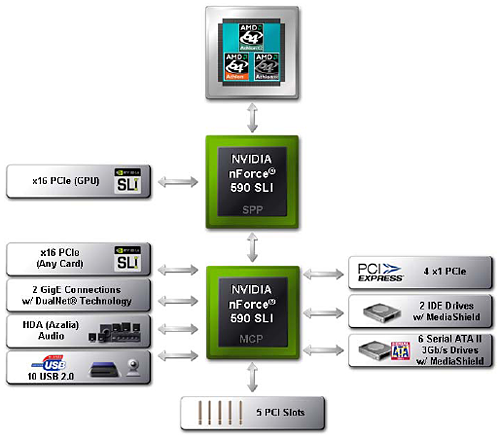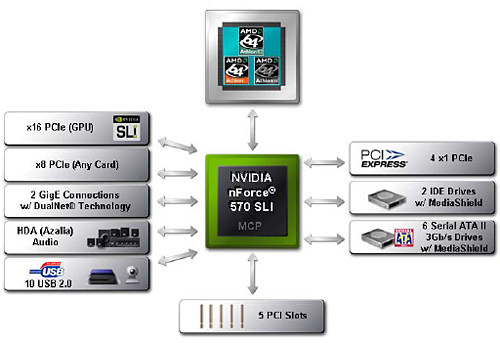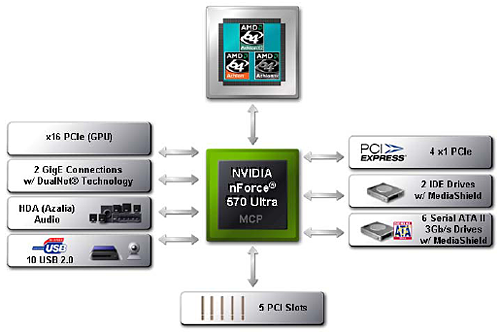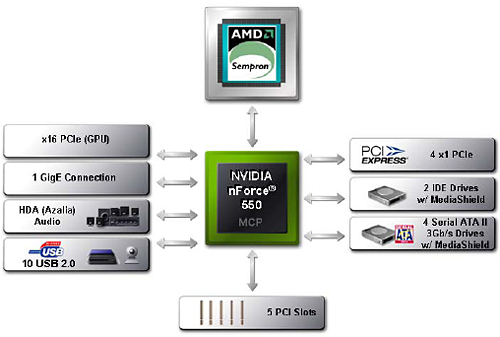nForce 500: nForce4 on Steroids?
by Gary Key & Wesley Fink on May 24, 2006 8:00 AM EST- Posted in
- CPUs
Basic Features: nForce 500 Platform
For the launch of socket AM2, NVIDIA is providing no less than four new product offerings dependent upon the market sector. With this product introduction NVIDIA is launching two new chipsets, the C51XE and MCP55PXE that form the basis for the four models. A quick summary of the new product choices can be found in the following table.| NVIDIA Chipset Breakdown | ||
| Market Segment | Socket 939 | Socket AM2 |
| High-End Enthusiast | nForce4 SLI X16 | nForce 590 SLI |
| Mainstream Enthusiast | nForce4 SLI | nForce 570 SLI |
| Performance Mainstream | nForce4 Ultra | nForce 570 Ultra |
| Value Mainstream | nForce4 4X | nForce 550 |
We expect the new socket AM2 motherboards to cost slightly more than their socket 939 counterparts, at least initially, but long-term they should have basically the same prices. The High-End Enthusiast segment will be around $200, Mainstream Enthusiast will be around $150, Performance Mainstream will be close to $100, and the Value Mainstream offerings will look to target the $80 or under market.

At the top of the product offering, the nForce 590 SLI consists of two chips, the C51Xe SPP and the MCP55PXE. This solution offers dual X16 PCI-E lanes for multiple graphics card configurations. While other features have changed, the overall design is very similar to the nForce4 SLI X16. The total number of PCI-E lanes is now 46, with 18 lanes coming from the SPP. Of those 18, two go unused at present and the remaining 16 are for the PEG slot.

One step down from the nForce 590 SLI is the nForce 570 SLI. This is a single chip solution, providing two X8 lanes for multiple graphics cards. A total of 28 lanes are of available, up from the 20 lanes that were available on the nForce4 SLI chipset. The 570 chipset also lacks the included LinkBoost technology but is otherwise the same as the 590.

The nForce 570 Ultra comes next, with a drop to 20 total PCI-E lanes. If the name didn't clue you in already, the Ultra also drops support for SLI. Basically, this is the "performance mainstream" offering, targeting users that are only interested in running single graphics cards. We do not expect a large difference in price between the 570 SLI and the 570 Ultra boards, and the $20 or so price premium might be worthwhile in order to have the extra PCI-E X16 slot. While at present only cards going into X16 slots are GPUs, depending on how long do you keep your next motherboard you might see additional options.

Rounding out the chipset offerings, the nForce 550 is the "value mainstream" product, taking over from the nForce4 4X. Several of the higher end options have been dropped from the 550 chipset, including support for dual Ethernet controllers, the FirstPacket technology, TCP/IP acceleration, and RAID 5. The number of natively supported SATA ports has also been reduced from six down to four. Whereas the other three chipsets are recommended for Athlon 64/FX/X2 users, the nForce 550 is recommended for Athlon 64 (single core) and Sempron users.
Here's a summary of the features and specifications of each chipset:
| Specification | |||||
| NVIDIA nForce 590 SLI |
NVIDIA nForce 4 SLI x16 |
NVIDIA nForce 570 SLI |
NVIDIA nForce 570 Ultra |
NVIDIA nForce 550 |
|
| Segment | Enthusiast SLI (2x16) |
Enthusiast SLI (2x16) |
Performance SLI (2x8) |
Performance | Mainstream |
| CPU Suggestion | Athlon 64 FX, Athlon 64 | Athlon 64 FX, Athlon 64 | Athlon 64 FX, Athlon 64 | Athlon 64 FX, Athlon 64 | Athlon 64, Sempron |
| SLI Technology | Yes | Yes | Yes | No | No |
| NVIDIA LinkBoost | Yes | No | No | No | No |
| NVIDIA FirstPacket | Yes | No | Yes | Yes | No |
| NVIDIA DualNet | Yes | No | Yes | Yes | No |
| Gigabit Connections | 2 | 2 - requires an external chipset | 2 | 2 | 1 |
| Teaming | Yes | No | Yes | Yes | No |
| TCP/IP Accleration | Yes | Yes, ActiveArmor | Yes | Yes | No |
| MediaShield | Yes | Yes | Yes | Yes | Yes |
| SATA / PATA Drives | 6 SATA 2 PATA |
4 SATA 4 PATA |
6 SATA 2 PATA |
6 SATA 2 PATA |
4 SATA 2 PATA |
| RAID | 0, 1, 0+1, 5 | 0, 1, 0+1 | 0, 1, 0+1, 5 | 0, 1, 0+1, 5 | 0, 1, 0+1 |
| NVIDIA nTune 5 | Yes | No | Yes | Yes | Yes |
| PCI Express Lanes | 46 | 38 | 28 | 20 | 20 |
| Links | 9 | 8 | 6 | 5 | 5 |
| USB Ports | 10 | 10 | 10 | 10 | 10 |
| PCI Slots Supported | 5 | 5 | 5 | 5 | 5 |
| Audio | Azalia | AC'97 | Azalia | Azalia | Azalia |










64 Comments
View All Comments
nullpointerus - Wednesday, May 24, 2006 - link
TCP/IP CPU utilization scales with increased transfer rates. Online gaming is hardly designed to stress a 1Gb Ethernet. So this TCP/IP acceleration is primarily intended for LAN gaming. You don't really need a firewall on your LAN (unless perhaps you are hosting a LAN party on that machine?). It's acceptable to use your router's firewall if you really know how to configure your LAN properly:Modem
|
Router
|
+--A (game server)
+--B (game client)
+--C (game client)
+--D (game client)
In this situation, TCP/IP acceleration might be useful. Of course, if you leave yourself open to your LAN and one of the other computers on your LAN is compromised, you could very well be compromised, too.
I don't understand the comments about a third-party firewall. Perhaps only XP and Vista's firewalls will be supported initially?
Trisped - Wednesday, May 24, 2006 - link
A true router can configure a firewall on all ports, both incoming and out going. In this way you can set what ports can be sent and what ports can be received through a router, in the LAN or out side as the case may be. Of course, software firewalls are usually a little more powerful in that they check who sends what. I think hardware firewalls can do this too, but they don't on any of the Linksys, Netgear, or AirLink routers I have used lately.It is also important to note that the typical home router is not a true router. It is a 2 port router (1 port for the WAN and 1 for the LAN) and the rest of the ports are connected via a switch or hub. Switches can also have firewall, but most home solutions don't seem to.
mino - Wednesday, May 24, 2006 - link
The info WHO sends teh data is the most crucial. Enabling http(80) just for Opera and 993+25 for Thundebird is a huge difference to allow al kinds of malware/spyware go out on 80.And NO, no HW (or second machine be it linux router or cisco router) can detect (reliably) which application is sending the data.
Gary Key - Wednesday, May 24, 2006 - link
I will clarify this in the article. Windows XP firewall is not supported. Vista should be but that decision is not final at this time due to continuing changes from Microsoft.
Tanclearas - Wednesday, May 24, 2006 - link
So does this mean Nvidia has abandoned AA in NF4? I know that is my impression, based upon my experience with them (http://forums.anandtech.com/messageview.aspx?catid...">http://forums.anandtech.com/messageview...mp;threa..., but just wondering what the official word is.Honestly, the idea behind Nvidia's chipset-based firewall was a good one, especially for universities/colleges with literally thousands of computers on the inside of the corporate firewall. Protection at every level is worthwhile.
As for the Vista firewall working with NF5, I definitely would not count on Nvidia making it happen.
Gary Key - Wednesday, May 24, 2006 - link
Once the new 9.x platform drivers are released with support for chipsets prior to nF5, then yes, Active Armor firewall will be dropped. The new driver set will also have further changes in them to reduce the possibility of data corruption on the nF4, whether the CPU utilization goes up or down, I do not know at this point. I do not have a "stable" set of new platform drivers for the nF4 yet, cannot verify this myself. I will be speaking with the program manager tomorrow. ;-)
We did find out that NVIDIA expected Microsoft to accomplish a few tasks in the Windows Firewall program, it did not happen, so they are pulling support as Microsoft decided to go a different direction in Vista. I have beta 2 on the way so there will be some test runs with the new driver set to see what happens. I will have a full statement on this subject by the end of the week. Apparently, there were several promises made, not kept, or not communicated properly about 18 months ago between the two parties about the Firewall program, OS hooks, and its future.
mbf - Monday, June 12, 2006 - link
Is the nVidia firewall truly gone? I've just downloaded (but not installed) the 9.34 driver pack from the nVidia FTP site. The pack still contains a NAM setup (v60.16).What exactly constitutes the ActiveArmour part of the firewall? The hardware firewall was introduced with the nForce3 250gb chipset and the AA functionality was added in nForce4. I've never figured out what precisely AA does, though.
If it's true that nVidia has pulled the firewall from the feature set I'd say it's a truly bad choice. For me, the hardware firewall was one of *the* most important features on the nForce chipset. Well, not having to wonder losing this feature will make my switch back to an Intel chipset-based Core 2 rig much easier. It's a shame.
Stele - Wednesday, May 24, 2006 - link
I was actually wondering if XP and Vista's firewalls would even be supported, since they're arguably 'third-party' from nVidia's viewpoint. While the argument for using hardware-based solutions in routers etc is cogent, imho there is a case for protecting individual PCs against compromise from within the network. For example, there may be laptops in the LAN that are used on several other (and potentially unsafe) networks as well. Besides that, software firewalls have the advantage of being able to potentially alert users to and stop malware from making unauthorised outbound connections from an infected PC (or unauthorised inbound connections from an infected LAN peer). I wonder if it's possible to get around the issue in future versions of firewall software - then at least it's not a lost cause, just that we would have to wait for newer versions of the software to be released.As for the actual usefulness of the TCP/IP offload engine, perhaps the folks at Anandtech can design a specific test that would stress such an engine's capability to the limit, to provide clear and objective assessment of its effect on performance. After all, Anandtech developed a good custom test suite for server benchmarks that targets specific application types, so I figure this would be well within their considerable programming skills as well ;)
Meanwhile, I wonder how nVidia's SATA controllers have improved if at all over the generations, and it would be great to eventually see an ULi 1575/SB600/MCP comparison in the future.
nullpointerus - Wednesday, May 24, 2006 - link
Correction:You don't really need a firewall on your LAN clients...
Gigahertz19 - Wednesday, May 24, 2006 - link
Expect the new kitchen when Conroe is launched :)